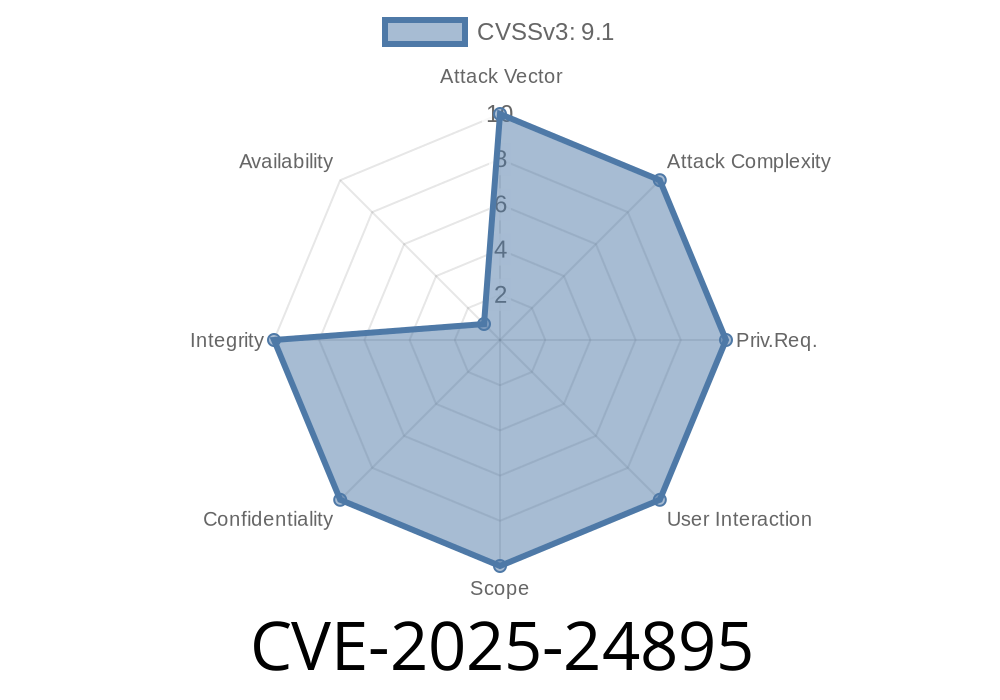CIE.AspNetCore.Authentication, an AspNetCore Remote Authenticator for CIE 3., has been found to contain a critical vulnerability affecting its SAML2 implementation. This vulnerability, identified as CVE-2025-24895, allows attackers to impersonate any Spid and/or CIE user when using vulnerable SDKs.
In this post, we'll explore the details of the vulnerability, its potential impact, and how to mitigate it. We'll also provide code snippets, links to original references, and an overview of the exploit.
Background
CIE.AspNetCore.Authentication is an AspNetCore Remote Authenticator for CIE 3. that focuses on providing user authentication using Spid and CIE. This system is based on the SAML2 standard, which offers two primary entities:
1. Identity Provider (IDP): Responsible for managing user credentials and identity, the IDP authenticates users and provides identity information (SAML affirmation) to the Service Provider (SP).
2. Service Provider (SP): Offering services to users, the SP relies on the IDP to authenticate users and grants access to resources based on SAML assertions received from the IDP.
In this context, the library cie-aspnetcore refers to the second entity (SP) and implements the validation logic of the SAML assertions within the SAML responses.
The Vulnerability - CVE-2025-24895
Affected versions of the CIE.AspNetCore.Authentication library lack assurance that the first signature refers to the root object. Consequently, if an attacker injects an item signed as the first element, all other signatures will not be verified.
To exploit this vulnerability, an attacker would only need to have an XML element legitimately signed by the IDP, which is easily achievable using the IDP's public metadata. With this in place, an attacker can create a malicious SAML response that would be accepted by SPs using vulnerable SDKs, enabling them to impersonate any Spid and/or CIE user.
Mitigation and Remediation
This issue has been addressed in version 2.1. of the CIE.AspNetCore.Authentication library, and all users are advised to upgrade as soon as possible. There are no known workarounds for this vulnerability.
Code Snippet Example (Vulnerable)
// This example demonstrates a vulnerable implementation of the SAML2 signature validation
private bool ValidateSignature(XmlElement samlResponse, X509Certificate2 idpCertificate)
{
// ... other validation logic ...
XmlNodeList elements = samlResponse.GetElementsByTagName("Signature");
XmlElement signatureElement = (XmlElement)elements[];
// The following line does not verify that the first signature refers to the root object
bool isValid = signature.CheckSignature(idpCertificate, true);
// ... other validation logic ...
return isValid;
}
Code Snippet Example (Fixed)
// This example demonstrates a fixed implementation of the SAML2 signature validation
private bool ValidateSignature(XmlElement samlResponse, X509Certificate2 idpCertificate)
{
// ... other validation logic ...
XmlNodeList elements = samlResponse.GetElementsByTagName("Signature");
XmlElement signatureElement = (XmlElement)elements[];
// The following line ensures that the first signature refers to the root object
bool isValid = signature.CheckSignature(samlResponse, idpCertificate, true);
// ... other validation logic ...
return isValid;
}
Conclusion
CVE-2025-24895 is a critical vulnerability in CIE.AspNetCore.Authentication that can result in user impersonation by attackers. Users of this library should upgrade to version 2.1. immediately to mitigate the risk. It is essential for developers to carefully implement security measures when working with authentication systems like CIE and SAML2 to prevent similar vulnerabilities in the future.
References
1. CIE.AspNetCore.Authentication Library - GitHub Repository
2. SAML2 Standard - Official Documentation
3. CVE-2025-24895 - Official CVE Details
Timeline
Published on: 02/18/2025 19:15:28 UTC
